The Latest Pre-Bunked Denialist Letter in Lieu of Real Science
Posted on 1 December 2012 by dana1981
For climate denialists, the preferred route by which to air their grievances about global warming is not via the scientific peer-review process, but rather through opinion letters published in the mainstream media. The reasons are obvious — a paper submitted to a peer-reviewed scientific journal must pass a fairly rigorous review by scientific experts, whereas a letter published in a newspaper does not undergo any expert review, and thus can contain whatever unsubstantiated nonsensical arguments the contrarians think the general public will believe.
The latest such letter was published in the Financial Post, authored by Tom Harris (who is best known for grossly misinforming Carleton University students about climate change in a Climate and Earth Science class he should never have been teaching). Harris convinced 125 mostly similarly unqualified individuals to sign the letter, including Anthony Watts, Joe Bastardi, Christopher Monckton, Nils-Axel Mörner, Oliver Manuel, Fritz Vahrenholt, Tim Ball, William Happer, Richard Cohen, Syun-Ichi Akasofu, Don Easterbrook, Joe D'Aleo, Ivar Giaever, Cliff Ollier, Fred Singer, Ole Humlum, Jan-Erik Solheim...the list of individuals with no climate expertise or with a history of being wrong on climate issues goes on and on and on.
Of course any scientific assertions should be evaluated based on their own merit, regardless of who makes them. As is always the case with these sorts of opinion letters, the Financial Post letter contains little more than a Gish Gallop of false, unsupported assertions. Fortunately we have already debunked most of them at Skeptical Science, so dispelling these zombie myths once more is a relatively simple task.
Denialists Pre-Bunked on Continued Global Warming
The main assertion, made several times in the letter, is a repeat of the myth that global warming stopped 16 years ago. This is one of the few arguments in the letter that has a shred of supporting evidence, as the contrarians claim:
"The U.K. Met Office recently released data showing that there has been no statistically significant global warming for almost 16 years."
This assertion quite clearly refers to the misleading Daily Mail article which was pre-bunked by Nuccitelli et al. (2012). While the measured global surface warming over the past 16 years is not statistically significant (0.047±0.128°C per decade), the central value is positive, meaning the average surface temperature has most likely warmed over this period. More importantly, rising global surface temperatures represent a very small percentage of overall global warming, most of which is borne out through the warming of the world's oceans (Figure 1). As Nuccitelli et al. (2012) showed, this global warming has continued unabated (Figure 2).
Figure 1: Components of global warming for the period 1993 to 2003 calculated from IPCC AR4 5.2.2.3.
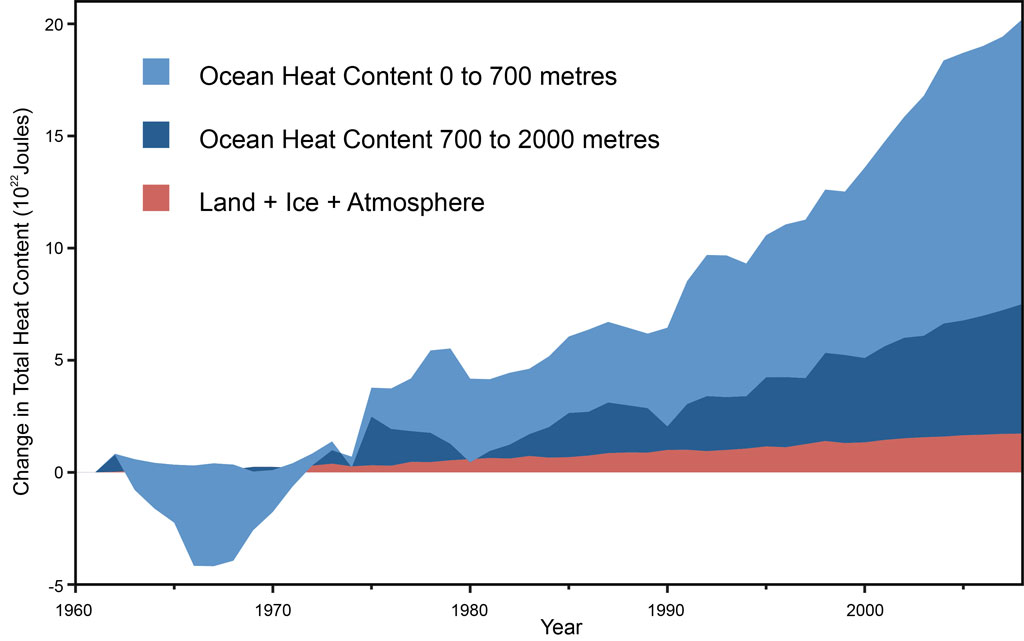
Figure 2: Land, atmosphere, and ice heating (red), 0-700 meter OHC increase (light blue), 700-2,000 meter OHC increase (dark blue). From Nuccitelli et al. (2012).
Denialists Pre-Bunked on Accurate Global Warming Projections
The climate denialsts also picked a very bad time to claim that global warming projections are exaggerated:
"Rigorous analysis of unbiased observational data does not support the projections of future global warming predicted by computer models now proven to exaggerate warming and its effects."
The timing is very poor because Rahmstorf et al. (2012) just pre-bunked this claim by verifying the accuracy of the global surface temperature projections made by the climate models used in the IPCC report (Figure 3).
Figure 3: Observed annual global temperature, unadjusted (pink) and adjusted for short-term variations due to solar variability, volcanoes and ENSO (red) as in Foster and Rahmstorf (2011). 12-month running averages are shown as well as linear trend lines, and compared to the scenarios of the IPCC (blue range and lines from the 2001 report, green from the 2007 report). Projections are aligned in the graph so that they start (in 1990 and 2000, respectively) on the linear trend line of the (adjusted) observational data.
Denialists Pre-Bunked on Solar Non-Cooling
Several climate contrarians who have predicted impending global cooling signed the letter, which contained the following assertion:
"Some scientists point out that near-term natural cooling, linked to variations in solar output, is also a distinct possibility."
Feulner & Rahmstorf (2010) examined the impact on global warming if the sun fell into a grand minimum. They found that average global surface temperature would be diminished by no more than 0.3°C, which would only offset a tiny fraction of human-caused global warming (Figure 4).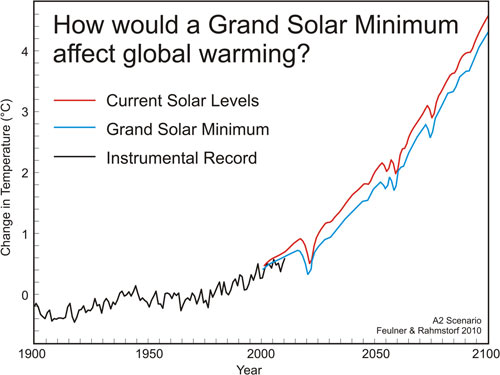
Figure 4: Global mean temperature anomalies 1900 to 2100 relative to the period 1961 to 1990 for the A2 scenario. The red line represents temperature change for current solar levels, the blue line represents temperature change at Maunder Minimum levels. Observed temperatures from NASA GISS until 2010 are also shown (black line) (Feulner & Rahmstorf 2010).
And how have those contrarian global cooling predictions (by Akasofu and Easterbrook, among others) fared thus far? Unlike the IPCC, not well at all (Figure 5).
Figure 5: Various best estimate global temperature predictions evaluated in the 'Lessons from Past Climate Predictions' series vs. GISTEMP (red). The warmer colors are generally mainstream climate science predictions, while the cooler colors are generally contrarian predictions.
Denialists Wrong on Extreme Weather
The letter steals from the Roger Pielke Jr. obfuscation playbook, trying to argue that climate change is not linked to extreme weather because thus far there is no clear link between human-caused global warming and economic losses from extreme weather. While the scientific evidence indicates that the intensity and/or frequency of many types of extreme weather is increasing due to human-caused global warming, there is not yet a clear trend in economic damage caused by extreme weather, when increases in population are taken into account. This may be in part to improving technology making our buildings and infrastructure more resistant to extreme weather.
Note the careful wording in the letter (emphasis added):
"The U.N.’s own Intergovernmental Panel on Climate Change says in its Special Report on Extreme Weather (2012) that there is “an absence of an attributable climate change signal” in trends in extreme weather losses to date."
However, the letter also asserts:
"The incidence and severity of extreme weather has not increased."
This is incorrect. For example, the same IPCC report on extreme weather cited by the contrarians states:
"It is likely that anthropogenic influences have led to warming of extreme daily minimum and maximum temperatures at the global scale. There is medium confidence that anthropogenic influences have contributed to intensification of extreme precipitation at the global scale. It is likely that there has been an anthropogenic influence on increasing extreme coastal high water due to an increase in mean sea level."
As noted above, there is a large and growing body of scientific literature finding not only that the incidence and severity of many types of extreme weather has increased, but also that human-caused global warming is the cause.
Denialists' Sandy Strawman
The letter is specifically addressed to United Nations Secretary-General H.E. Ban Ki-Moon, and the contrarians falsely accuse him of "making unsupportable claims that human influences caused [Hurricane Sandy]." In reality, Ban Ki-Moon did not say climate change caused Hurricane Sandy, he said:
"...extreme weather due to climate change is the new normal."
This is true — as discussed above, climate change is increasing the frequency and/or intensity of many types of extreme weather. Human-caused global warming also amplified the impacts of Hurricane Sandy.
Wrong, Unsupported, and Misguided Denialists
Ultimately the denialists advise that we should not try to mitigate global warming by reducing greenhouse gas emissions, but that we should instead focus our efforts on adapting to "all dangerous climatic events however caused." While adaptation is a necessary step due to the impacts from already-caused climate change, adaptation alone is an insufficient response. As we frequently quote Lonnie Thompson saying about the consequences of human-caused climate change,
"The only question is how much we will mitigate, adapt, and suffer."
We simply cannot adapt to the probable catastrophic consequences of a continued business-as-usual path. If these contrarians want to make a convincing case that the consequences will not be bad and adaptation is sufficient, they need to make the case in the peer-reviewed scientific literature, as mainstream climate scientists do. It would be foolish to be convinced by a letter published by a list of non-experts in a newspaper, full of false, long-debunked, and unsubstantiated assertions. The public deserve better from scientists.































 Arguments
Arguments





















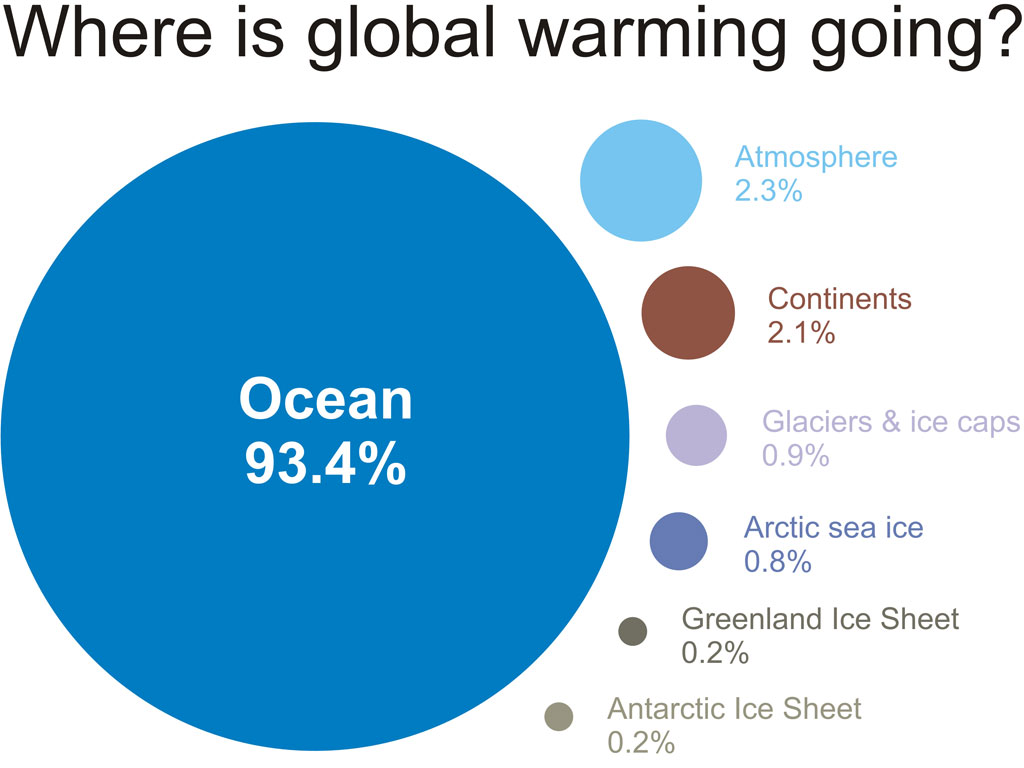
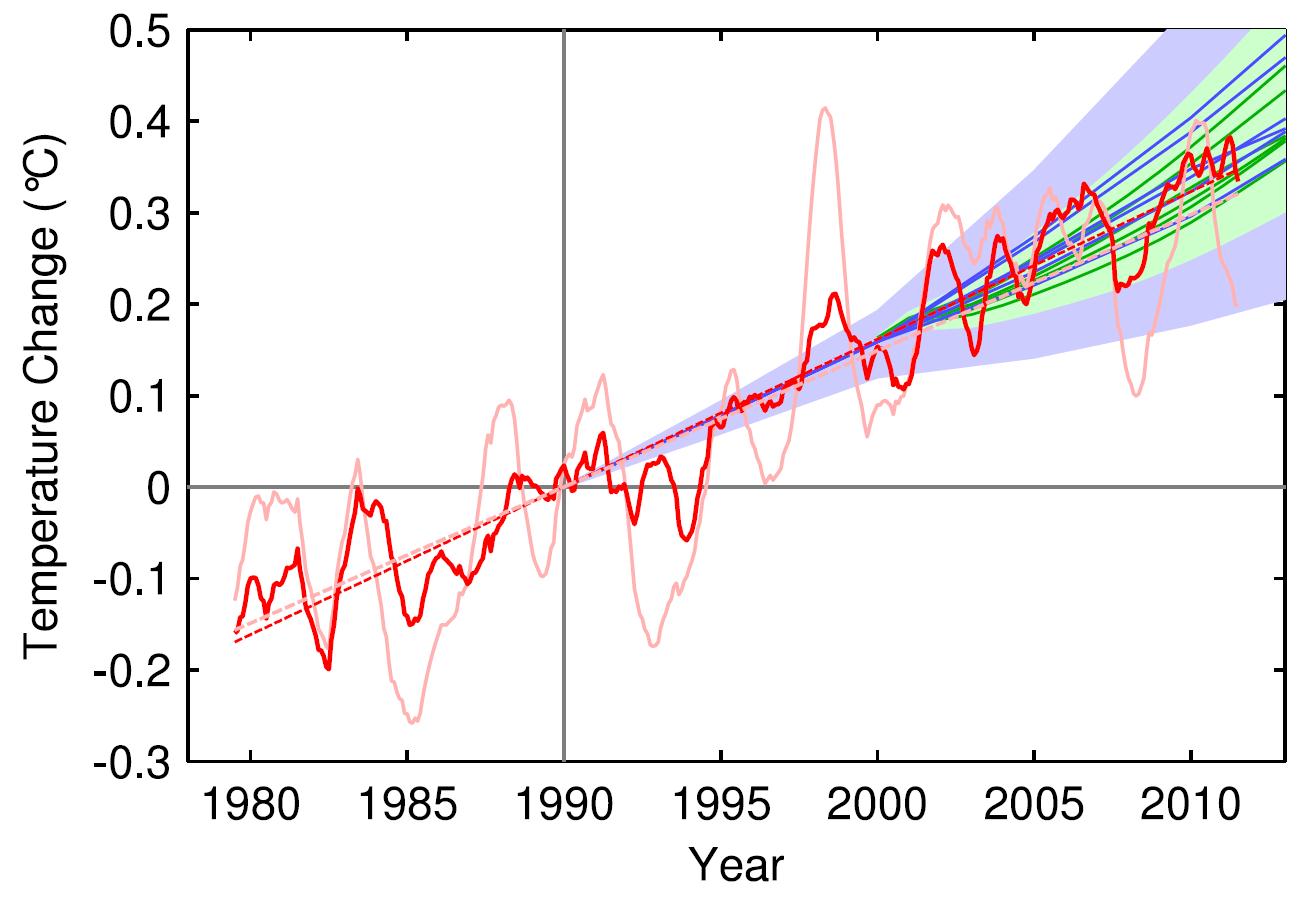
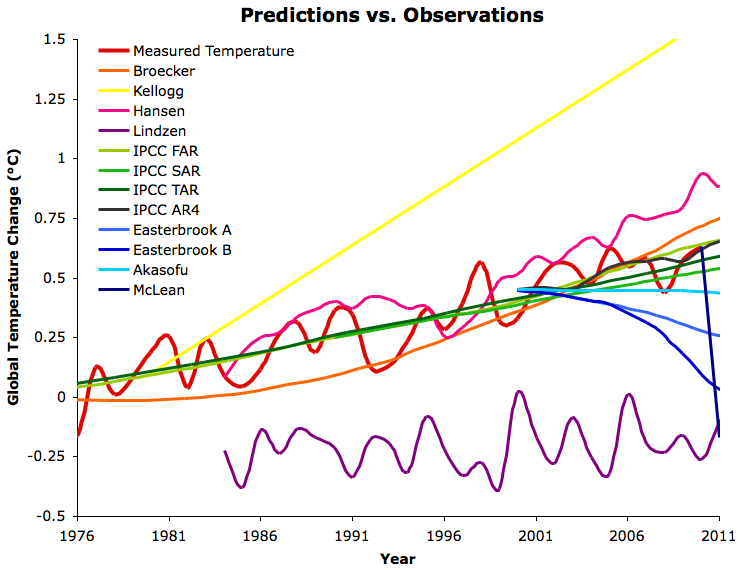









[Sph] We can delete what's here, but we don't have tools to easily move comments (yet, look for it in 2013). You should re-enter the comment in the right place, and when you do, I'll delete these.
[DB] First comment is deleted; please repost on the correct thread per SPH.